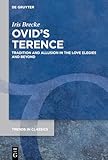Ovid’s Terence : Tradition and Allusion in the Love Elegies and Beyond / Iris Brecke.
Material type: TextSeries: Trends in Classics - Supplementary Volumes ; 156Publisher: Berlin ; Boston : De Gruyter, [2023]Copyright date: ©2024Description: 1 online resource (XXIII, 158 p.)Content type:
TextSeries: Trends in Classics - Supplementary Volumes ; 156Publisher: Berlin ; Boston : De Gruyter, [2023]Copyright date: ©2024Description: 1 online resource (XXIII, 158 p.)Content type: - 9783111307039
- 9783111308548
- 9783111308036
- 871/01 23/eng/20240130
- PA6537 .B74 2024
- online - DeGruyter
- Issued also in print.
| Item type | Current library | Call number | URL | Status | Notes | Barcode | |
|---|---|---|---|---|---|---|---|
 eBook
eBook
|
Biblioteca "Angelicum" Pont. Univ. S.Tommaso d'Aquino Nuvola online | online - DeGruyter (Browse shelf(Opens below)) | Online access | Not for loan (Accesso limitato) | Accesso per gli utenti autorizzati / Access for authorized users | (dgr)9783111308036 |
Frontmatter -- Acknowledgements -- Contents -- Introduction -- 1 Defending artes: Terentian allusions in Tristia 2 -- 2 Marriage, rape and status: the Roman tradition -- 3 Love as disease: the love cure -- 4 Genre and conditions: slaves, lovers and the slavery of love -- 5 Poetic imagery: militant love -- 6 Ovid’s Terence: omnia mutantur, nihil interit -- Bibliography -- Index
restricted access online access with authorization star
http://purl.org/coar/access_right/c_16ec
This book investigates the complex reception of Terence in Ovid and a number of allusions to the Terentian comedies in the love elegies and the exilic elegiac epistle Tristia 2. The genres of Latin love elegy and New Comedy are often seen as closely connected in research, and one leading view is that Latin love elegy to a large degree springs out of the comic genre. However, though both genres are strongly rooted in social practise and presents interpersonal relationships in a non-mythological, everyday setting, there are also major differences between them. Marriage, for instance, is the conventional goal for the young lover withing the comic genre, whereas the elegiac lover should avoid it. Taking into account both the similarities and the crucial differences between the comic genre and Latin love elegy, and key elegiac topoi such as seruitium amoris and militia amoris, this book demonstrates an intricate connection between Ovid and Terence, and a complex nexus of allusions that goes straight to the core of Ovid’s elegiac authorship. Winner of the Trends in Classics Book Prize 2023
Issued also in print.
Mode of access: Internet via World Wide Web.
In English.
Description based on online resource; title from PDF title page (publisher's Web site, viewed 02. Jun 2024)


